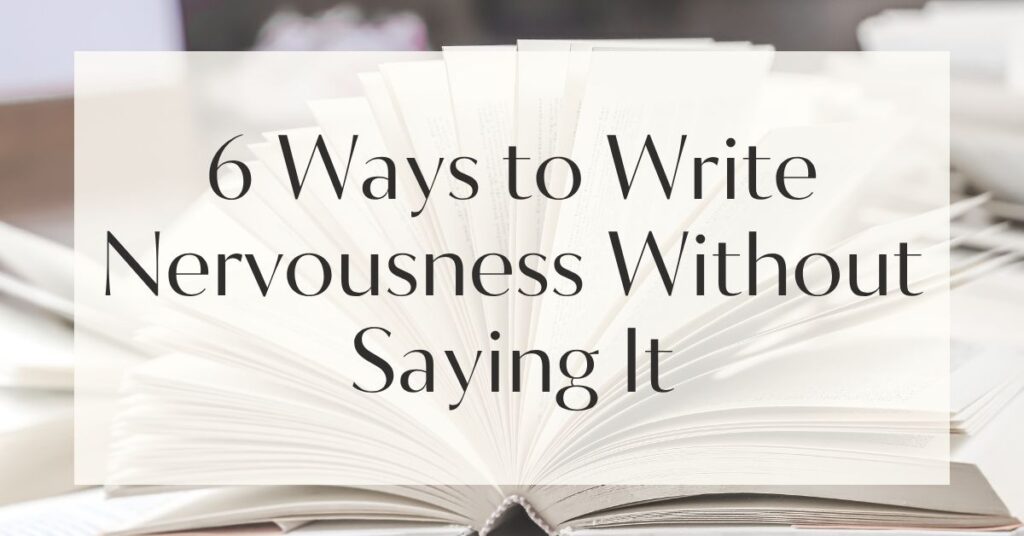Ever been on the edge of your seat, heart racing, palms sweaty, wondering how to capture the essence of nervousness in writing? You’re not alone. Crafting a scene that vibrates with tension without explicitly stating the emotion can be as elusive as chasing shadows.
Yet, mastering this art can elevate your storytelling to new heights, pulling readers into your characters’ minds and making them feel every heartbeat. Dive into the world of subtlety and intrigue as we explore six inventive techniques to write nervousness without ever saying it outright.
Understanding Nervousness in Writing
Nervousness is more than just a feeling; it’s a symphony of physical cues, emotional triggers, and psychological responses that transform a simple moment into a gripping narrative. But why is it so crucial to show rather than tell when it comes to emotions in writing?
The Importance of Showing Emotions
Imagine reading a story where the author merely states emotions like “he was nervous” or “she was scared.” The words fall flat, leaving no room for the reader’s imagination or empathy.
By showing emotions in writing, you invite readers to experience the narrative on a visceral level, engaging their senses and emotions. This approach transforms passive reading into an active journey, where readers live the story alongside your characters.
Common Triggers of Nervousness
Nervousness can be triggered by many situations—public speaking, a first date, or a looming deadline. Understanding these triggers can help you craft scenes that resonate with authenticity. Consider the character’s background, fears, and desires.
A character who fears failure might break into a cold sweat during a critical presentation, while another might fidget uncontrollably when faced with a romantic interest. These nuances add depth to your characters and make their experiences relatable.

Creative Techniques to Write Nervousness
Now that we’ve established the importance of showing emotions, let’s explore some creative writing techniques that will help you convey nervousness effectively in your storytelling.
Body Language and Physical Cues
Body language is a powerful tool for depicting nervousness. Characters might exhibit subtle signs like biting their nails, tapping their feet, or avoiding eye contact. These physical manifestations offer readers a window into the character’s inner turmoil without overtly stating it.
Consider how different characters might react physically to nervousness. A confident character might clench their jaw and maintain a stiff posture, while a more timid character could shrink into themselves, their eyes darting around the room.
Observe people in real-life situations to enrich your writing. Notice how individuals express nervousness through their body language. Incorporate these observations into your characters, making their reactions believable and varied.
Google Docs is for notes. Scrivener is for novels. Upgrade your writing game and try it for free today!

Dialogue that Conveys Anxiety
Dialogue is another avenue to express nervousness. Characters may stutter, speak in fragmented sentences, or over-explain themselves. Their words might tumble out in a rush, betraying their anxious state.
Alternatively, they might fall silent, their reluctance to speak highlighting their discomfort. Dialogue reveals a character’s state of mind and their relationship dynamics. A nervous character might interrupt or talk over others, desperate to fill the silence with anything but their thoughts.
Setting and Atmosphere to Evoke Nervousness
The setting can amplify a character’s nervousness. A dimly lit room, the clock ticking, or the oppressive heat of a summer afternoon can all contribute to a character’s unease. Use sensory details to paint a vivid picture that mirrors the character’s internal state.
For instance, a character waiting for an important phone call might notice the walls closing in, the air feeling too thick to breathe. These atmospheric elements immerse readers in the scene, allowing them to feel the character’s tension.
- Use dim lighting or shadows to create a sense of foreboding.
- Incorporate sounds like a ticking clock or distant thunder to heighten tension.
- Describe the environment’s impact on the character, such as a stifling room or a chilling breeze.
Examples from Literature and Film
Great storytellers across media have mastered the art of depicting nervousness. Let’s explore some iconic scenes and character reactions that showcase this skill.

Iconic Scenes that Showcase Nervousness
Consider the scene in “The King’s Speech” where King George VI struggles with his speech impediment. The camera focuses on his clenched fists, the beads of sweat on his forehead, and how he swallows hard before speaking.
These visual cues convey his anxiety without needing to state it outright. Similarly, in J.K. Rowling’s “Harry Potter” series, Harry’s nervousness before a Quidditch match is palpable through his restless pacing and the tight knot in his stomach.
Character Reactions in High-Pressure Situations
In “To Kill a Mockingbird,” Harper Lee masterfully depicts Scout’s nervousness during the trial scene through her fidgeting and the way she grips her brother’s hand. The tension in the courtroom is mirrored in her small, anxious movements.
In film, consider the character of Frodo Baggins in “The Lord of the Rings.” His nervousness is evident in his wide eyes and trembling hands as he faces the daunting task of destroying the One Ring.
Feeling lost with your debut novel?
Fiverr Pro connects you with expert editors, designers, and marketers – everything you need to get your book ready for success!

Building Emotional Depth in Your Characters
Creating characters with emotional depth requires more than just surface-level traits. By incorporating backstory and relatable flaws, you can enrich their emotional journey and engage readers deeper.
Using Backstory to Enhance Emotional Impact
A character’s past can significantly influence their present emotional state. A traumatic event or a pivotal moment can shape how they react to stress or fear.
Revealing these backstories gradually can add layers to your characters, making their nervousness more understandable and poignant. For example, a character ridiculed in childhood might struggle with public speaking as an adult, their nervousness rooted in those past experiences.
Crafting Relatable Characters with Flaws
Flaws make characters human and relatable. A character who is overly critical of themselves might exhibit nervousness through self-doubt and second-guessing.
By embracing these imperfections, you create characters that readers can connect with, understand their vulnerabilities, and root for their growth. Remember, flaws and struggles often make characters memorable and endearing.
When developing characters, focus on their unique flaws and how these might manifest under pressure. This will make their reactions to nervous situations authentic and relatable.

Final Thoughts on Writing Nervousness
Writing about nervousness without explicitly stating it is an art that requires attention to detail and a deep understanding of human behavior. You can craft scenes that resonate with readers and bring your characters to life by employing creative techniques and drawing inspiration from literature and film.
No marketing platform? No social following? No problem!
Publisher Rocket helps you market your debut novel like a pro.
It’s a gamechanger for debut authors – try it today!


Embracing Vulnerability in Your Writing
Don’t shy away from exploring vulnerability in your characters. Allow them to falter, to face their fears, and to grow from their experiences.
Vulnerability is a powerful tool in storytelling, inviting readers to empathize and invest in your characters’ journeys. By embracing the messiness of human emotions, you create a narrative that feels real and compelling.
Encouragement for Writers to Explore Emotions
As writers, we can explore the vast spectrum of human emotions. Dive into nervousness, fear, and anxiety, and let your characters lead the way.
Experiment with different techniques, draw inspiration from your own experiences, and don’t be afraid to take risks. Remember, writing is a journey, and each story is an opportunity to explore the complexities of the human condition.
Experiment with different narrative techniques to find what works best for your story. Whether it’s through dialogue, setting, or character development, let your creativity guide you in expressing emotions authentically.








